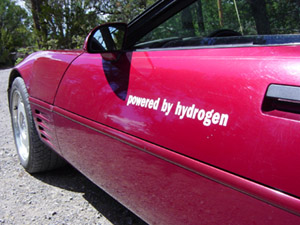
This page is from
www.unitednuclear.com for more information
please go to their site!

![]()
![]()
Status:
Final Patents in Process
General sales are expected to start in the third quarter of 2004.

|
United Nuclear is currently in final testing, and will shortly be producing Hydrogen conversion systems / Hydrogen generators for most fuel injected, Gasoline powered vehicles. Powering
a vehicle by Hydrogen is by no means a new idea, and in fact, almost
all automobile manufacturers are currently developing a new generation
of vehicles that run on Hydrogen as opposed to Gasoline. This new
generation of vehicles are essentially electric cars that use a Fuel
Cell instead of a battery to run the electric motor. Using a chemical
process, Fuel Cells in these new vehicles convert the stored Hydrogen
on board, and the Oxygen in the air, directly into electricity to
power their electric motors. These new vehicles are very efficient,
and in fact are more efficient than any internal combustion engine.
The problem is that these new vehicles are years away from production,
are very expensive, and converting to using Hydrogen fuel in this
manner requires you to buy a new ( and expensive ) vehicle. All
Hydrogen/Fuel Cell systems currently under development by large
manufacturers have you purchase Hydrogen as you would Gasoline.
|
![]()
|
What's Real?
A lot has been written about converting vehicles to run hydrogen.
Unfortunately, a lot of what you'll find on the internet is simply
untrue. Storage
Since you can't make Hydrogen quickly enough to power a car in real
time, you must produce it separately, and store it as you store your
Gasoline fuel supply in your vehicle now. 1.
Store the Hydrogen as a compressed gas. We'll cover each option in order. 1. If you choose to store the Hydrogen as a compressed gas, you'll need HUGE tanks, and many of them, since Hydrogen isn't very dense, so a tank really can't hold all that much. In addition, you'll be driving a giant bomb. In a collision, expect to die in a huge fireball/explosion. 2. Choosing liquid does solve the density problem since liquids are far more dense than gasses, so you can reduce the amount of tanks and their sizes required to power the car. The new problem that pops up is the fact the liquid Hydrogen in cryogenic... in short REALLY cold. It requires vacuum-thermos ( dewar ) tanks and vents to exhaust the boiling Hydrogen gas. You'll also have to find a source for liquid Hydrogen which is far more expensive than Gasoline. You've also now increased you danger factor when it comes to a collision. Not only will you have more Hydrogen gas spewing around that's going to explode and burn, but you'll also have a liquid spraying about that's over 400 degrees below zero. Once you add in the added complexity of the system due to the cryogenic liquid, your vehicle will wind up being a giant, low efficiency, rolling bomb that costs more than your house, and costs far more to run than it did on Gasoline. 3.
The 3rd option is simply the only way to go. There are materials call
Hydrides that absorb Hydrogen like a sponge absorbs water. Typically,
the tanks are filled with granulated Hydrides, and Hydrogen is
pressurized into the material. Hydrides have many advantages over
liquid & gas. One is that the density of the Hydrogen stored in
the Hydride can be GREATER than that of liquid Hydrogen. This
translates directly into smaller and fewer storage tanks.
Our vehicle starts on Gasoline and runs for about 5 minutes to heat
everything up ( including the Hydride ). The time it takes to heat up
the Hydride is about as long as it takes the heater in your car to
warm up and blow out hot air. As soon at the Hydride is sufficiently
warm, Hydrogen is released from the tanks and the on-board computer
detects the presence of Hydrogen pressure.
The only exhaust products from using Hydrogen as a fuel are steam (
water vapor ) and a tiny amount of Nitrogen Oxides. It's about as
clean burning as you can get. |
|
|
|
|
"Short
Range" Hydride tank placement in Corvette. |
Close-up shot of the updated Hydride tank installation. |
|
Currently, the biggest stumbling block of the Hydrogen fuel system at
this point is the cost of the metal Hydride itself. At current prices,
the required amount of metal Hydride costs between $7,000 to
$18,000 per vehicle. We use a base blend of
Iron/Titanium/Manganese/Lithium Hydride with a few other trace metals
that increase efficiency. We are actively working with the chemical
manufacturer to reduce the price of this material. We're now
told that we can expect a 70% reduction in Hydride costs once
production is geared up for expected demand. This would reduce the
cost of the Hydride storage tanks to $3,000 to $5,000 per vehicle. Our second headache deals with tank refilling. If air (or Oxygen) ever contacts the Hydride material, it is permanently destroyed. Our current prototype refilling system purges the fuel lines & tanks with Argon gas prior to filling to ensure there is no residual air left in the fuel refill line. This is a clumsy & time consuming process that we should have eliminated by the time sales are ready. |